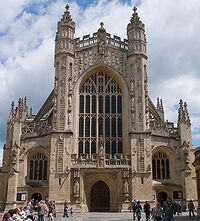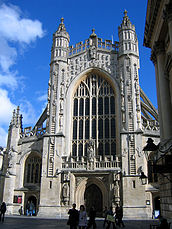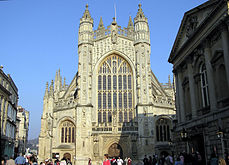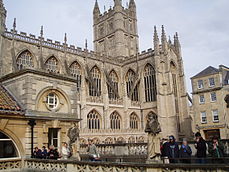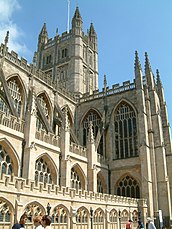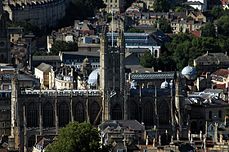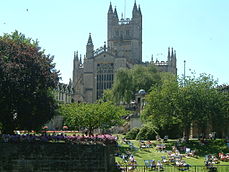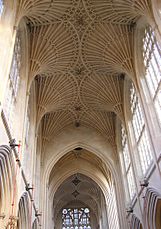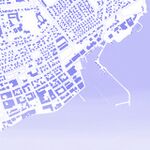Inscríbete y crea tu propia colección de obras y artículos
Diferencia entre revisiones de «Abadía de Bath»
Ir a la navegaciónIr a la búsqueda
m (Texto reemplaza - '<center><gallery widths="240px" heights="240px" perrow="3">' a '<center><gallery widths="229px" heights="229px" perrow="3">') |
m (Texto reemplaza - '[[Imagen:' a '[[Archivo:') |
||
| Línea 1: | Línea 1: | ||
[[ | [[Archivo:060529-17-BathAbbey.jpg|thumb|right|200px|Portada de la Abadía de Bath]] | ||
La '''Abadía de San Pedro''' en [[Bath]] ([[Somerset]], Inglaterra), más conocida simplemente como '''Abadía de Bath''' es una [[iglesia]] [[Anglicanismo|anglicana]], y anteriormente un [[monasterio]] Benedictino. Fundada en el siglo VII, reorganizada en el siglo X y reconstruida en los siglos XII|XII y XVI, es uno de los mayores ejemplos de [[Gótico perpendicular]] del sudoeste de Inglaterra. Se trata de una iglesia de planta [[cruciforme]], con capacidad para aproximadamente 1.200 personas. Se emplea para servicios religiosos, ceremonias civiles y conferencias.<ref>{{cite web |url=http://www.bathabbey.org/ |title=Bath Abbey |accessdate=2007-09-27 |format= |work=Bath Abbey }}</ref> | La '''Abadía de San Pedro''' en [[Bath]] ([[Somerset]], Inglaterra), más conocida simplemente como '''Abadía de Bath''' es una [[iglesia]] [[Anglicanismo|anglicana]], y anteriormente un [[monasterio]] Benedictino. Fundada en el siglo VII, reorganizada en el siglo X y reconstruida en los siglos XII|XII y XVI, es uno de los mayores ejemplos de [[Gótico perpendicular]] del sudoeste de Inglaterra. Se trata de una iglesia de planta [[cruciforme]], con capacidad para aproximadamente 1.200 personas. Se emplea para servicios religiosos, ceremonias civiles y conferencias.<ref>{{cite web |url=http://www.bathabbey.org/ |title=Bath Abbey |accessdate=2007-09-27 |format= |work=Bath Abbey }}</ref> | ||
<!-- | <!-- | ||
| Línea 31: | Línea 31: | ||
Little is known about the first building on this site, described by King Edwy as being "marvellously built". Given the town's origins, the first church may have occupied the site of an earlier [[Paganism|pagan]] temple. | Little is known about the first building on this site, described by King Edwy as being "marvellously built". Given the town's origins, the first church may have occupied the site of an earlier [[Paganism|pagan]] temple. | ||
[[ | [[Archivo:Bath Abbey Fan Vaulting - July 2006.jpg|thumb|right|The nave with its fan vaulting]] | ||
===Norman church=== | ===Norman church=== | ||
| Línea 40: | Línea 40: | ||
===Monuments=== | ===Monuments=== | ||
[[ | [[Archivo:WilliamBinghamMemorialBathAbbey20040731 CopyrightKaihsuTai.jpg|right|thumb|[[William Bingham|Bingham]] memorial]] | ||
The Abbey is home to several notable [[memorials]], including those dedicated to [[Beau Nash]], Admiral [[Arthur Phillip]], [[Isaac Pitman]], James Montague (Bishop of Bath and Wells), Lady Waller (wife of [[William Waller]], a [[Roundhead]] military leader in the [[English Civil War]]), Elizabeth Grieve (wife of James Grieve, physician to Elizabeth, Empress of Russia), [[Sir William Baker]], [[John Sibthorp]], [[Richard Hussey Bickerton]], [[Admiral]] [[Arthur Phillip]] (first Governor of Australia), [[William Hoare]], [[Richard Bickerton]] and US Senator [[William Bingham]]. | The Abbey is home to several notable [[memorials]], including those dedicated to [[Beau Nash]], Admiral [[Arthur Phillip]], [[Isaac Pitman]], James Montague (Bishop of Bath and Wells), Lady Waller (wife of [[William Waller]], a [[Roundhead]] military leader in the [[English Civil War]]), Elizabeth Grieve (wife of James Grieve, physician to Elizabeth, Empress of Russia), [[Sir William Baker]], [[John Sibthorp]], [[Richard Hussey Bickerton]], [[Admiral]] [[Arthur Phillip]] (first Governor of Australia), [[William Hoare]], [[Richard Bickerton]] and US Senator [[William Bingham]]. | ||
| Línea 48: | Línea 48: | ||
The first mention of an organ in the Abbey dates to 1634, but nothing is known of this instrument. The first properly recorded organ in Bath Abbey was built by [[Abraham Jordan]] in 1708 on a new gallery installed in place of the medieval [[rood screen]], which had been removed earlier, with similarly disastrous results to those seen at Durham Cathedral. It was modified in 1718 and 1739 by Jordan's son. The specification recorded in 1800 was one of twenty stops spread over three manuals.<ref name="NPOR - Bath Abbey's Jordan organ">{{cite web|title=Bath Abbey: The Jordan organ|url=http://npor.emma.cam.ac.uk/cgi-bin/Rsearch.cgi?Fn=Rsearch&rec_index=N05914 | work=The National Pipe Organ Register | publisher=British Institute of Organ Studies | year=1802? | accessdate=2007-09-18}}</ref> The compasses of the manuals were extended, one and a half octaves of pedals were added and the instrument renovated in [[1802]] by John Holland; further repairs were effected by [[Flight & Robson]] in 1826.<ref name="Poliquin"/> This instrument was removed first to the Bishop's Palace at Wells in 1836,<ref name="NPOR - The Bishop's Palace, Wells">{{cite web|title=The Bishop's Palace, Wells|url=http://npor.emma.cam.ac.uk/cgi-bin/Rsearch.cgi?Fn=Rsearch&rec_index=E00460 | work=The National Pipe Organ Register | publisher=British Institute of Organ Studies | year=c.1838 | accessdate=2007-09-18}}</ref> then to [[St Mary's Church, Yatton|St Mary's Church]], [[Yatton]], where it was later rebuilt and extensively modified.<ref name="NPOR - Saint Mary's, Yatton">{{cite web|title=Saint Mary the Virgin, Yatton|url=http://npor.emma.cam.ac.uk/cgi-bin/Rsearch.cgi?Fn=Rsearch&rec_index=A01146 | work=The National Pipe Organ Register | publisher=British Institute of Organ Studies | year=1971 | accessdate=2007-09-18}}</ref> | The first mention of an organ in the Abbey dates to 1634, but nothing is known of this instrument. The first properly recorded organ in Bath Abbey was built by [[Abraham Jordan]] in 1708 on a new gallery installed in place of the medieval [[rood screen]], which had been removed earlier, with similarly disastrous results to those seen at Durham Cathedral. It was modified in 1718 and 1739 by Jordan's son. The specification recorded in 1800 was one of twenty stops spread over three manuals.<ref name="NPOR - Bath Abbey's Jordan organ">{{cite web|title=Bath Abbey: The Jordan organ|url=http://npor.emma.cam.ac.uk/cgi-bin/Rsearch.cgi?Fn=Rsearch&rec_index=N05914 | work=The National Pipe Organ Register | publisher=British Institute of Organ Studies | year=1802? | accessdate=2007-09-18}}</ref> The compasses of the manuals were extended, one and a half octaves of pedals were added and the instrument renovated in [[1802]] by John Holland; further repairs were effected by [[Flight & Robson]] in 1826.<ref name="Poliquin"/> This instrument was removed first to the Bishop's Palace at Wells in 1836,<ref name="NPOR - The Bishop's Palace, Wells">{{cite web|title=The Bishop's Palace, Wells|url=http://npor.emma.cam.ac.uk/cgi-bin/Rsearch.cgi?Fn=Rsearch&rec_index=E00460 | work=The National Pipe Organ Register | publisher=British Institute of Organ Studies | year=c.1838 | accessdate=2007-09-18}}</ref> then to [[St Mary's Church, Yatton|St Mary's Church]], [[Yatton]], where it was later rebuilt and extensively modified.<ref name="NPOR - Saint Mary's, Yatton">{{cite web|title=Saint Mary the Virgin, Yatton|url=http://npor.emma.cam.ac.uk/cgi-bin/Rsearch.cgi?Fn=Rsearch&rec_index=A01146 | work=The National Pipe Organ Register | publisher=British Institute of Organ Studies | year=1971 | accessdate=2007-09-18}}</ref> | ||
[[ | [[Archivo:Organ of Bath Abbey.JPG|thumb|right|Organ, in north transept]] | ||
The abbey's next organ was built in 1836 by John Smith of [[Bristol]], to a specification of thirty stops over three manuals and pedals.<ref name="NPOR - Bath Abbey's Smith organ">{{cite web|title=Bath Abbey: The Smith of Bristol organ|url=http://npor.emma.cam.ac.uk/cgi-bin/Rsearch.cgi?Fn=Rsearch&rec_index=N05915 | work=The National Pipe Organ Register | publisher=British Institute of Organ Studies | year=1836 | accessdate=2007-09-18}}</ref> This instrument was rebuilt on a new gallery in the North [[Transept]] by [[William Hill & Son]] of [[London]] in 1868, to a specification of forty stops spread over four manuals and pedals, although the Solo department, which would have brought the total to well over forty, was not completed.<ref name="NPOR - Bath Abbey's Hill organ">{{cite web|title=Bath Abbey: The Hill organ|url=http://npor.emma.cam.ac.uk/cgi-bin/Rsearch.cgi?Fn=Rsearch&rec_index=N05922 | work=The National Pipe Organ Register | publisher=British Institute of Organ Studies | year=1868 | accessdate=2007-09-18}}</ref> It was mostly removed to the [[Church of St Peter & St Paul, Cromer|Church of St Peter & St Paul]], [[Cromer]] in 1896, the remainder being kept for incorporation in the new abbey organ.<ref name="NPOR - Cromer Parish Church">{{cite web|title=Cromer Parish Church|url=http://npor.emma.cam.ac.uk/cgi-bin/Rsearch.cgi?Fn=Rsearch&rec_index=N06212 | work=The National Pipe Organ Register | publisher=British Institute of Organ Studies | year=1912 | accessdate=2007-09-18}}</ref> | The abbey's next organ was built in 1836 by John Smith of [[Bristol]], to a specification of thirty stops over three manuals and pedals.<ref name="NPOR - Bath Abbey's Smith organ">{{cite web|title=Bath Abbey: The Smith of Bristol organ|url=http://npor.emma.cam.ac.uk/cgi-bin/Rsearch.cgi?Fn=Rsearch&rec_index=N05915 | work=The National Pipe Organ Register | publisher=British Institute of Organ Studies | year=1836 | accessdate=2007-09-18}}</ref> This instrument was rebuilt on a new gallery in the North [[Transept]] by [[William Hill & Son]] of [[London]] in 1868, to a specification of forty stops spread over four manuals and pedals, although the Solo department, which would have brought the total to well over forty, was not completed.<ref name="NPOR - Bath Abbey's Hill organ">{{cite web|title=Bath Abbey: The Hill organ|url=http://npor.emma.cam.ac.uk/cgi-bin/Rsearch.cgi?Fn=Rsearch&rec_index=N05922 | work=The National Pipe Organ Register | publisher=British Institute of Organ Studies | year=1868 | accessdate=2007-09-18}}</ref> It was mostly removed to the [[Church of St Peter & St Paul, Cromer|Church of St Peter & St Paul]], [[Cromer]] in 1896, the remainder being kept for incorporation in the new abbey organ.<ref name="NPOR - Cromer Parish Church">{{cite web|title=Cromer Parish Church|url=http://npor.emma.cam.ac.uk/cgi-bin/Rsearch.cgi?Fn=Rsearch&rec_index=N06212 | work=The National Pipe Organ Register | publisher=British Institute of Organ Studies | year=1912 | accessdate=2007-09-18}}</ref> | ||
Revisión del 10:21 28 ago 2011
La Abadía de San Pedro en Bath (Somerset, Inglaterra), más conocida simplemente como Abadía de Bath es una iglesia anglicana, y anteriormente un monasterio Benedictino. Fundada en el siglo VII, reorganizada en el siglo X y reconstruida en los siglos XII|XII y XVI, es uno de los mayores ejemplos de Gótico perpendicular del sudoeste de Inglaterra. Se trata de una iglesia de planta cruciforme, con capacidad para aproximadamente 1.200 personas. Se emplea para servicios religiosos, ceremonias civiles y conferencias.[1]
Otras imágenes
Detalle de los ángeles que suben y bajan por la Escalera de Jacob, fachada oeste
Referencias
- ↑
Bath Abbey. Bath Abbey. Consultado el 2007-09-27.
Enlaces externos
Bath Abbey}}
